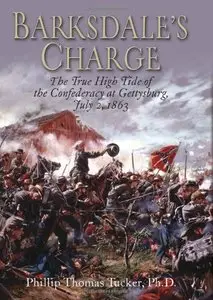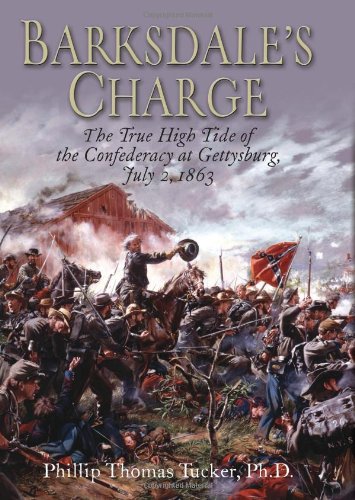Phillip Thomas Tucker, "Barksdale's Charge: The True High Tide of the Confederacy at Gettysburg, July 2, 1863"
ISBN: 1612001793 | 2013 | EPUB | 336 pages | 5 MB
On the third day of Gettysburg, Robert E. Lee launched a magnificent attack. For pure pageantry it was unsurpassed, and it also marked the centerpiece of the war, both time-wise and in terms of how the conflict had turned a corner—from persistent Confederate hopes to impending Rebel despair. But Pickett’s Charge was crushed by the Union defenders that day, having never had a chance in the first place.The Confederacy’s real “high tide” at Gettysburg had come the afternoon before, during the swirling conflagration when Longstreet’s corps first entered the battle, when the Federals just barely held on. The foremost Rebel spearhead on that second day of the battle was Barksdale’s Mississippi brigade, which launched what one (Union) observer called the "grandest charge that was ever seen by mortal man.”Barksdale’s brigade was already renowned in the Army of Northern Virginia for its stand-alone fights at Fredericksburg. On the second day of Gettysburg it was just champing at the bit to go in. The Federal left was not as vulnerable as Lee had envisioned, but had cooperated with Rebel wishes by extending its Third Corps into a salient. Hood’s crack division was launched first, seizing Devil’s Den, climbing Little Round Top, and hammering in the wheatfield.Then Longstreet began to launch McLaws’ division, and finally gave Barksdale the go-ahead. The Mississippians, with their white-haired commander on horseback at their head, utterly crushed the peach orchard salient and continued marauding up to Cemetery Ridge. Hancock, Meade, and other Union generals desperately struggled to find units to stem the Rebel tide. One of Barksdale’s regiments, the 21st Mississippi, veered off from the brigade in the chaos, rampaging across the field, overrunning Union battery after battery. The collapsing Federals had to gather men from four different corps to try to stem the onslaught.Barksdale himself was killed at the apex of his advance. Darkness, as well as Confederate exhaustion, finally ended the day’s fight as the shaken, depleted Federal units on their heights took stock. They had barely held on against the full ferocity of the Rebels, on a day that decided the fate of the nation. Barksdale’s Charge describes the exact moment when the Confederacy reached its zenith, and the soldiers of the Northern states just barely succeeded in retaining their perfect Union.Phillip Thomas Tucker, Ph.D. Has authored or edited over 20 books on various aspects of the American experience, especially in the fields of Civil War, Irish, African-American, Revolutionary, and Southern history. A native of St. Louis, Missouri, he has earned three degrees in American history, including a Ph.D. From St. Louis University in 1990. For over two decades, Dr. Tucker served as a military historian for the U.S. Air Force. He currently lives in the vicinity of Washington, DC. REVIEWS Though long overshadowed by the more famous Pickett-Pettigrew-Trimble Charge of July 3, the advance of Barksdale's men from Seminary Ridge, through the Peach Orchard, and across Plum Run toward Cemetery Ridge has been referred to as "the grandest charge ever seen by mortal man." Here for the first time is the story of Barksdale's Mississippians and their gallant charge told with the detail and passion it so richly deserves. Phil Tucker has produced a wonderful addition to the library of the most discerning Gettysburg collector."Terrence Winschel, Historian (retired), Vicksburg National Military Park, Vicksburg, Mississippi"While Pickett’s Charge, on day three of Gettysburg, has received numerous book-length treatments and become a phrase for the ages, Barksdale’s charge the day before has not. Gen. William Barksdale, former secessionist U.S. Congressman, was in command of four Mississippi regiments in Lt. Gen. James Longstreet’s corps, directed to attack from the woods, wheel northward, and break the Union lines. Barksdale got the go-ahead to charge as dusk approached. On his horse driving his troops onward, he seemed to have the Federals on the run. It was this moment, says Tucker quite reasonably, that was really the high-water mark for the Confederacy rather than Pickett’s Charge the next day. Had Barksdale paused to regroup and then charge again, perhaps, perhaps…. But he spurred his troops on, was mortally wounded, and the Union forces were able to hold on to fight another day. Tucker sets his narrative within the context of the battles and personalities leading up to that day’s near victory for the Confederacy."—Library JournalThanks to Tucker’s incisive analysis of the facts surrounding Gettysburg, Barksdale’s Mississippians will now stand tall, claiming from Pickett’s Virginians long-deserved recognition for having achieved the Confederacy’s true zenith. Presenting an exhilarating narrative based on rigorous re-interpretation of historical sources, scholars and lay readers will soon recognize the Southern nation’s high water mark as the second day at Gettysburg. —Darryl E. Brock, co-author of Cubans in the Confederacy“The author of the acclaimed Exodus from the Alamo does more “mythbusting” in this superbly argued book. “Armchair General



